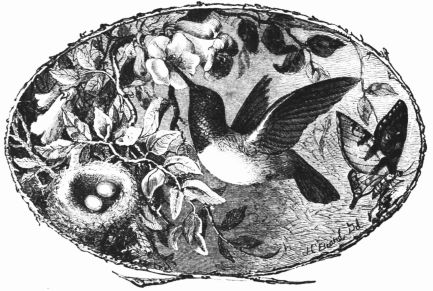Little Green Hummer
By Mary Mapes Dodge
Annotations by Mary Miller/KK

Little green Hummer
Was born in the summer;
His coat was as bright
As the emerald’s light.
Short was his song,
Though his bill it was long;
His weight altogether
Not more than a feather.
From dipping his head
In the sunset red,
And gilding his side
In its fiery tide,
He gleamed like a jewel,
And darted around,
‘Twixt sunlight and starlight,
Ne’er touching the ground.
Now over a blossom,
Now under, now in it;
Here, there, and everywhere,
All in a minute.
Ah! never he cared
Who wondered and stared,—
His life was completeness
Of pleasure and sweetness;
He revelled in lightness,
In fleetness and brightness
This sweet little Hummer
That came with the summer.
Dodge, Mary Mapes. “Little Green Hummer.” In Rhymes and Jingles, 14. New York: Scribner, Armstrong and Company, 1875.
Contexts
Mary Mapes Dodge (1831-1905) was born in 1831 in New York. She made her most significant contribution to the body of late nineteenth and twentieth-century children’s literature and childhood education with her work as an editor of St. Nicholas Magazine. The magazine published poems, stories, and educational articles for children, and by children, on topics ranging from history to science to nature. Contributors included luminaries such as Louisa May Alcott, Rudyard Kipling, Mark Twain, and Frances Hodgson Burnett. The magazine remains a rich source of insight into the education of children during that era.
Of particular interest is the “St. Nicholas League” section of submissions from readers. Works included sketches, paintings, photographs, poems, and stories. The editors recognized the best works with awards and prizes. Several famous writers were first published in the magazine, including Edna St. Vincent Millay, E. B. White, and Bennet Cerf. St. Nicholas was in circulation from 1873 to 1943, and Dodge remained as editor until her death in 1905.
Dodge also worked as an associate editor for Hearth and Home magazine alongside Harriet Beecher Stowe. Like many nineteenth-century writers, Stowe was also fascinated hummingbirds. Search for her sketch, “Hum, the Son of Buz,” elsewhere in The Envious Lobster.
Resources for Further Study
- Short biography of Mary Mapes Dodge and a selection of her poems.
- Read Paul Rosta’a article “The Magazine That Taught Faulkner, Fitzgerald, and Millay How to Write.”
- Download the Cornell Lab of Ornithology’s Guide to Attracting Hummingbirds.
Contemporary Connections
Climate change is threatening hummingbirds by disrupting their patterns of migration and feeding routines. As bloom times change they may arrive at a known source of nutrition too early or too late. In short, they have become out of synch with nature. Scientists are still studying the problem and possible remedies, but you can help by turning your home into a hummingbird haven and following other tips in the article “Turn Your Yard Into A Hummingbird Spectacular,” published in Audubon Magazine.